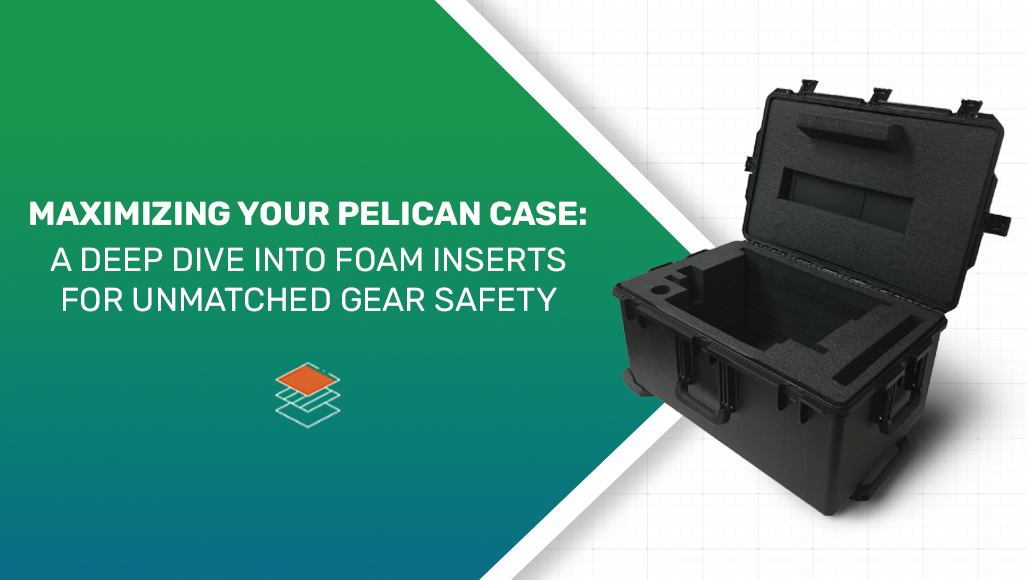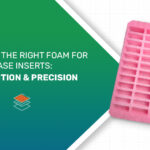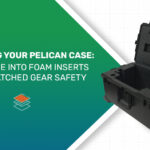Blog

Maximizing Your Pelican Case: A Deep Dive into Foam Inserts for Unmatched Gear Safety
Pelican cases are globally recognized for their formidable, virtually indestructible exteriors, offering a shield against the harshest conditions. Features such as waterproof and airtight seals, crushproof designs, and automatic pressure equalization valves have cemented their reputation as a cornerstone of protection across numerous industries and activities. However, the true preservation of sensitive and valuable equipment often hinges on an element within: the Pelican Case Insert. While the robust shell guards against external onslaughts, it is the meticulously chosen and configured foam interior that defends against internal movement, absorbs shock, and mitigates vibration. The exterior of a Pelican case provides critical environmental protection, safeguarding contents from water, dust, and impact. Concurrently, the internal Pelican Case Foam delivers essential kinetic and organizational protection, cushioning items from the jolts of transit and ensuring they remain securely in place. This dual-component system is fundamental to achieving comprehensive gear safety. Neglecting the quality or design of the foam insert effectively leaves the job half-done, potentially undermining the case’s protective capabilities for the very items it is meant to secure.
This comprehensive guide will delve into every critical aspect of Foam Inserts for Pelican Cases. Readers will gain the knowledge to confidently select the appropriate foam materials, understand various customization techniques, apply effective layout strategies, and properly maintain their inserts. The ultimate goal is to empower users to transform their Pelican case into a tailored sanctuary, ensuring their valuable equipment achieves unmatched safety, organization, and longevity.
Why Your Pelican Case Demands the Perfect Foam Companion
The legendary toughness of a Pelican case’s exterior is only part of the protection equation. The internal environment, specifically the foam cushioning system, plays an equally vital role in safeguarding valuable equipment. Understanding the science behind foam’s protective qualities and its organizational benefits reveals why a perfect foam companion is not just an accessory, but a necessity.
Beyond the Rugged Exterior: The Science of Shock Absorption and Vibration Dampening
The primary function of foam inserts within a Pelican case is to absorb and dissipate energy from impacts and vibrations, preventing these forces from reaching and damaging the stowed equipment. When a case experiences a drop or a sudden jolt, the foam compresses, absorbing the shock. As it recovers its shape, it releases this energy slowly, rather than transferring it directly to the contents. Different foam materials, with varying densities and cell structures (open-cell or closed-cell), exhibit different compression and recovery characteristics, allowing for tailored protection based on the fragility and weight of the items.
Vibration dampening is another crucial aspect, particularly for sensitive electronics, calibrated instruments, or optical gear. During transportation, equipment can be subjected to continuous, lower-energy agitations. Quality foam isolates the items from these vibrations, preventing gradual misalignment, loosening of components, or cumulative stress that can lead to malfunction. The strategic inclusion of shock absorption properties within customized foam inserts acts as a protective buffer, effectively mitigating the impact of external forces encountered during transit, whether navigating uneven terrain or the rigors of shipping.
The Organizational Advantage: Efficiency, Accessibility, and Professional Presentation
Beyond mere protection, Foam Inserts for Pelican Cases offer significant organizational benefits. Custom-designed cutouts ensure that every piece of equipment has its own dedicated space, preventing items from shifting and colliding with each other during transit. This meticulous arrangement leads to several operational advantages.
Firstly, it enhances efficiency. Packing and unpacking become faster and more streamlined when each item has a clearly defined spot. Secondly, it allows for quick inventory control; a glance into the case immediately reveals if any component is missing, which is invaluable in fast-paced environments or when managing numerous pieces of gear. For instance, portable tool kits with custom foam inserts aid in inventory control and ensure that essential tools are present and accounted for at a glance.
Furthermore, a well-organized Pelican Case with Foam projects an image of professionalism and meticulous care for one’s equipment. For professionals presenting equipment to clients or working on site, this organized presentation can significantly enhance their perceived competence and reliability. The unveiling of custom foam inserts is akin to a meticulously curated presentation, where each item assumes its designated and easily identifiable position. This systematic organization not only improves accessibility but also elevates the user’s professional image. The benefits thus extend beyond damage prevention to include operational efficiency and even brand perception, making the choice of foam an investment in workflow optimization.
Protecting Your Investment: How Quality Pelican Case Foam Extends Equipment Life
Valuable equipment represents a significant investment. The right Pelican Case Foam plays a crucial role in protecting this investment by extending the operational life of the gear. By minimizing movement, shock, and vibration, foam inserts reduce the wear and tear that equipment endures during transport and handling. This prevents not only catastrophic damage from major impacts but also the subtle, cumulative harm that can shorten an item’s lifespan.
Cosmetic damage, such as scratches and dents, is significantly reduced, maintaining the equipment’s appearance and resale value. More importantly, functional damage to delicate internal components or the calibration of sensitive instruments is prevented. Pelican cases, with their high-quality materials and protective seals, safeguard the value of their contents from environmental factors; the foam insert is integral to preventing internal damage that similarly affects this value. Foam engineered to withstand prolonged usage retains its form and protective attributes over time, ensuring consistent and reliable protection throughout the equipment’s lifecycle. Ultimately, quality foam preserves not just the physical integrity of the gear, but also its operational readiness and overall value.
Decoding Foam: A Comprehensive Guide to Material Choices for Your Pelican Case Insert
Selecting the ideal foam for a Pelican Case Insert is a critical decision, as not all foams offer the same protective qualities or durability. The choice hinges on a careful assessment of the gear’s characteristics—its weight, fragility, and value—as well as the anticipated environmental conditions and handling. Aligning the material with specific needs is paramount. Different foam types possess distinct properties regarding cell structure, density, shock absorption capabilities, and resistance to elements like water and chemicals.
Polyurethane (PU) Foam
- Characteristics: Polyurethane (PU) foam is a soft, open-cell foam characterized by its spongy texture. It “feels soft to the touch” and is designed to provide excellent shock absorption, particularly for lighter impacts and delicate items.
- Best Uses: PU foam is ideally suited for lightweight and delicate items that require gentle cushioning. Common applications include camera equipment, photography gear, medical and laboratory instruments, consumer electronics with sensitive screens, and luxury product packaging where a high-end feel is desired. It is often recommended for items like glass, cameras, and other electronic equipment.
- Pros: The primary advantages of PU foam are its softness and flexibility, allowing it to conform well to the shape of items and absorb shock effectively. It is also lightweight and generally cost-effective, making it a budget-friendly option for certain applications. Its open-cell structure also makes it suitable for custom engraving.
- Cons: PU foam is less durable over time compared to denser, closed-cell foams. It can compress or wear out with frequent use. A significant drawback is its open-cell structure, which makes it prone to absorbing moisture and renders it not water-resistant. This can lead to degradation in humid environments.
Polyethylene (PE) Foam
- Characteristics: Polyethylene (PE) foam is a closed-cell foam known for its rigid structure and higher density, offering excellent impact resistance and firm, shock-resistant padding. It is described as “long-lasting and dense”.
- Best Uses: PE foam is the go-to choice for protecting heavy or high-value equipment. It excels in applications such as military and tactical gear (firearms, drones), industrial tool cases, aerospace and automotive components, and trade show or sales kits where items need to be held securely. It is well-suited for heavy objects that can absorb significant shock, such as firearms and tools.
- Pros: PE foam boasts high durability and longevity, being resistant to wear and tear. Its closed-cell nature makes it water-resistant and chemical-resistant, ideal for outdoor or industrial environments. It also offers excellent durability against extreme temperatures. Furthermore, PE foam is easily customizable using CNC cutting and laser etching for intricate designs. It is also non-abrasive and non-dusting.
- Cons: While excellent for firm support, PE foam provides less soft cushioning than PU foam, which might not be ideal for extremely delicate items requiring a gentler touch.
Cross-Linked Polyethylene (XLPE) Foam
- Characteristics: Cross-linked Polyethylene (XLPE) foam is a premium, closed-cell foam often regarded as the highest quality material for protective case inserts. It is renowned for its exceptional durability, resilience, visually appealing smooth surface, and soft touch, sometimes described as a mix between rubber and foam. The cross-linking process, either chemical or through irradiation, enhances its physical properties, making it more robust and stable.
- Best Uses: XLPE is ideal for applications demanding the utmost protection and presentation, such as for medical devices, sales presentation kits, high-value sensitive instruments, firearms, and any equipment requiring Class “A” surface protection (protection against scratches on fine finishes).
- Pros: XLPE foam is extremely long-lasting and durable. It effectively protects class “A” surfaces. Its closed-cell structure provides excellent thermal insulation, water resistance, and chemical resistance. It offers superior shock absorption and has a great strength-to-weight ratio, making it an excellent shipping foam.
- Cons: Due to the additional processing involved in cross-linking, XLPE foam is generally more expensive than non-cross-linked polyethylene foams. While it has good thermal properties, its performance in extremely high-temperature environments may be limited compared to other specialized materials.
Specialty Foams
- Anti-Static Foam: Easily identifiable by its characteristic pink color, anti-static foam is specifically formulated to dissipate electrostatic charges. This property is crucial for protecting sensitive electronic components such as CPUs, transistors, LEDs, integrated circuits (ICs), and other electrostatic-sensitive devices (ESDs) from damage.
- Layered/Colored Foams: Innovations in foam design include multi-layered and colored foam systems that enhance organization and protection.
- Shadow Foam®, for example, is a multi-layered polyethylene foam that allows users to create custom inserts by simply cutting and peeling layers, revealing a contrasting color underneath. This provides a clear visual indication of where tools or items belong and if anything is missing, enhancing organization and efficiency.
- Topper Foams, offered by Pelican, consist of a thin, heavy-duty colored 6lb Polyethylene layer laminated to a sturdy 2lb black Polyethylene base. These are designed to improve visual organization, durability, and quick equipment identification. Different colors serve specific purposes: red highlights critical or high-priority equipment, blue is for general organization and frequently accessed tools, and yellow offers high visibility for efficient tool management and safety. These layered systems provide robust shock absorption while optimizing workflow.
The existence of basic foams like PU and PE caters to general protective needs. However, the development and availability of advanced materials like XLPE signal a response to demands for higher performance, superior aesthetics, and enhanced protection for increasingly sensitive or valuable equipment. Furthermore, the emergence of specialty foams such as anti-static variants and application-specific colored or layered systems like Topper Foams and Shadow Foam demonstrates a clear trend towards solving highly specific user problems, be it electrostatic discharge protection, tool control, or rapid equipment identification. This progression suggests that as the technology and value of equipment escalate, the supporting protective solutions, including foam inserts, must also evolve to become more sophisticated and precisely tailored. This implies that foam selection is increasingly a technical decision, requiring a deeper understanding of material properties and application needs.
Customization Pathways: Tailoring Your Pelican Case Foam for a Flawless Fit
Once the appropriate foam material is chosen, the next step is to customize it to securely cradle the equipment. There are two primary pathways for creating Foam Inserts for Pelican Cases: the do-it-yourself (DIY) approach using Pick ‘N’ Pluck foam, and the professional solution involving custom-cut inserts. The best path depends on factors like budget, complexity of the gear, required precision, and desired durability.
The DIY Approach: Mastering Pick ‘N’ Pluck Foam
Pick ‘N’ Pluck foam is a common offering with many Pelican cases, providing an accessible way for users to create their own custom interiors. This foam typically consists of one or more layers that are pre-scored into small, removable cubes, often with a solid base pad layer underneath. Users can manually pluck out these cubes to form cavities that approximate the shape of their items.
- Advantages: The main appeal of Pick ‘N’ Pluck foam is its low cost and ease of use for relatively simple shapes and layouts. It requires no special tools and is well-suited for one-off customizations or very low volume needs where the investment in fully engineered foam isn’t justified.
- Limitations: Despite its convenience, Pick ‘N’ Pluck foam has several drawbacks.
- Durability: It is considerably less durable than custom-engineered foam and can tear or degrade over time, especially if the walls between items are thin or if the foam is subjected to frequent use. Some users find it is “not going to last” and can start “falling apart after about a month” with regular use.
- Precision: The cavities created are approximate and lack the precise fit of professionally cut foam. This can lead to more movement of items than desired.
- Appearance: The resulting insert often lacks the clean, professional look of custom-cut solutions, which may be a concern for presentations or sales kits.
- Time: For complex layouts or multiple cases, customizing Pick ‘N’ Pluck foam can be a time-consuming process.
- Structural Integrity: Removing too many cubes or placing items too close together can weaken the overall structure of the foam, leading to distortion or failure. This highlights a nuanced reality: Pick ‘N’ Pluck foam is praised for its accessibility and cost-effectiveness, yet often criticized for its shortcomings in durability and precision. This isn’t a contradiction but reflects varying user priorities. For a hobbyist with a single piece of equipment used infrequently, Pick ‘N’ Pluck might be perfectly adequate. However, for a professional relying on the secure transport of thousands of dollars worth of gear daily, its limitations can become significant liabilities. The choice, therefore, is highly context-dependent.
The Professional Solution: Precision with Custom-Cut Foam Inserts
For applications demanding superior protection, organization, and durability, professionally custom-cut foam inserts are the preferred solution. This approach is particularly recommended for high-value or exceptionally fragile equipment, complex geometric shapes, situations requiring multiple identical case setups, or when a highly professional presentation is essential.
- A Glimpse into the Technology & Process: The creation of custom foam inserts is a sophisticated process that often mirrors high-tech industrial manufacturing, justifying the investment for those with critical protection needs.
- CAD Design & 3D Modeling: The process typically begins with designers working closely with the client to understand the equipment and its intended use. Precise measurements of each item are taken, or sample products are used to create an exact layout using Computer-Aided Design (CAD) software. This design phase considers not only the dimensions of the equipment but also factors like layering strategy for varying depths, necessary cutouts for accessories (cables, batteries), and ergonomic considerations like finger slots for easy handling.
- Material Selection: Based on the CAD design and the characteristics of the items (weight, fragility, value, environmental exposure), the most suitable foam material (e.g., PE, XLPE, Anti-Static) is selected.
- Precision Cutting Methods: Advanced cutting technologies are employed to fabricate the foam inserts with high precision:
- Die Cutting: Uses a steel rule die to stamp out shapes, best for high-volume production of identical inserts.
- CNC (Computer Numerical Control) Routing: Uses computer-controlled cutting tools for precise shaping, perfect for complex multi-depth designs.
- Adhesive Bonding & Layering (If Needed): For inserts requiring significant depth, multiple storage compartments, or the integration of different foam densities for zoned protection, layers of foam are bonded together using industrial adhesives.
- Finishing & Quality Control: Before full production, a sample insert is typically tested with the actual equipment to ensure a perfect fit and proper protective function. Each production piece then undergoes rigorous quality control, including fit testing, drop and impact testing (simulating real-world conditions), and surface inspection for any flaws. Pelican, for instance, developed the original “Fragility Curve” table, still used globally, to ensure correct foam use in technical packaging.
Investing in a Pelican Case with Foam that has been professionally customized means benefiting from an engineered protective solution, ensuring that the internal safeguarding matches the renowned toughness of the case’s exterior.
Designing Your Gear’s Sanctuary: Essential Layout Principles for Foam Inserts for Pelican Cases
The effectiveness of a Pelican Case Foam Insert is not solely dependent on the material or customization method; the layout design is equally crucial. A well-thought-out arrangement ensures optimal protection, maximizes usable space, and enhances accessibility. Effective foam insert layout design is often a careful balancing act between maximizing protection (which might suggest more spacing and foam), optimizing space (fitting as much gear as possible), and ensuring user accessibility and workflow efficiency. There is no single “right” way; the ideal layout is highly dependent on the specific gear, its value, and the user’s operational needs. Poor layout planning, such as placing items too close together, incorrect orientation for access, or improper weight distribution, can lead to reduced protection, difficult handling, inefficient use of valuable case space, and ultimately, user frustration. A well-designed insert can significantly enhance the usability of the entire Pelican case system.
The Blueprint: Accurate Measurement and Meticulous Planning
The foundation of any successful foam insert design, whether DIY or professional, is precision.
- Measure Accurately: Begin by meticulously measuring each item that will be housed in the case. This includes not just the primary dimensions (length, width, depth) but also any unique contours, protrusions, or accessories that need accommodation. For custom-cut foam, designers often work from these precise dimensions or even a sample of the product.
- Plan the Layout: Before any cutting or plucking begins, create a detailed layout plan. This can be done by sketching on paper, using grid paper to represent the foam, or even arranging the items directly on top of the foam layer to visualize their placement. Consider the frequency of use for each item; those accessed more often should be positioned for easier reach. For Pick ‘N’ Pluck foam, this involves laying out all the kit on top of the foam and using markers like toothpicks or chalk to delineate the boundaries of each item.
Strategic Spacing: Buffering Items from Each Other and Case Walls
Proper spacing is paramount to prevent items from colliding with each other or with the hard interior walls of the case during impacts.
- Wall Clearance: Maintain a minimum of 1 inch of foam between any item and the case walls, especially critical for protecting sensitive components like optics from side impacts.
- Inter-Item Spacing (Pick ‘N’ Pluck):
- For lightweight items, a minimum separation of 1/2 inch (approximately 1.5 cm) is generally advised.
- For delicate lightweight items such as cameras or laptops, a separation of 1 inch to 1.5 inches (2.5 cm to 4 cm) is suggested.
- For heavier items, typically weighing between 10 to 20 lbs, allow for 1.5 to 2 inches (4 cm to 5 cm) of separation.
- A common rule of thumb is to have at least one full cube wall of Pick ‘N’ Pluck foam between items. However, for better stability and to prevent tearing of the foam walls, leaving two to three rows of foam squares (or “spaces”) between items is highly recommended, particularly for heavier or frequently accessed gear.
- The objective is to create an even cushion throughout the entire case, ensuring no two items can make direct contact.
Weight, Orientation, and Accessibility
The physical characteristics of the items and how they will be used should dictate their placement.
- Weight Distribution: For Pelican cases equipped with wheels, strategically place heavier items towards the wheeled end of the case. This makes the case easier to roll and maneuver. Aim for a balanced load overall to prevent tipping and ensure comfortable carrying.
- Orientation: Consider the orientation of each item for both protection and ease of access. For example, when storing firearms, it’s often recommended to position them with the bolt side up and oriented so the rifle is facing downrange when the case is opened on a shooting bench. Prioritize the placement of frequently used items for quick and easy retrieval.
- Fit: A snug fit is generally better as it minimizes the movement of objects during travel. However, avoid overstuffing the case, as this can put undue pressure on the items and the foam, potentially compromising protection.
Leveraging Layers: Multi-Depth Designs for Complex Kits
Layered foam designs are invaluable when dealing with items of varying heights or when aiming to maximize the storage capacity of a single case.
- Pick ‘N’ Pluck Depth Adjustment: With multi-layer Pick ‘N’ Pluck sets, the depth of a pocket can be adjusted. After plucking out the shape in the top layer, the corresponding block in the layer(s) beneath can be removed or partially cut horizontally to create a deeper cavity for taller items.
- Custom Foam Layering: Professional designers explicitly plan the “depth & layering strategy” during the CAD phase. This can involve using multiple layers of the same foam or even combining different foam densities in different layers to achieve specific protective characteristics for different parts of an item.
- Organizational Layers: Colored foam layers, such as those found in Shadow Foam or Pelican’s Topper Foams, serve an organizational purpose. A contrasting color revealed when an item is removed can instantly indicate a missing tool or component, aiding in inventory control and visual organization.
Smart Slots: Multi-Purpose Cutouts and Accessory Management
Efficiently managing accessories is key to a well-organized case.
- Dedicated Accessory Cutouts: Design specific cutouts for essential accessories such as cables, batteries, chargers, memory cards, manuals, or small tools. This keeps them secure and prevents them from damaging or being damaged by larger items.
- Multi-Purpose Slots: Consider designing some slots with versatility in mind. For example, a videographer might create a camera body slot that is also large enough to accommodate an audio recorder or a small light, allowing flexibility depending on the specific gear needed for a shoot.
- Accessory Pouches: For very small, numerous, or less critical accessories like loose cables or adapters, it might be more space-efficient to store them in a small travel bag or a lid organizer within the Pelican case, rather than dedicating precious foam space to individual cutouts.
- Ease of Access Features: Incorporate design elements like finger cutouts or pull tabs to make it easier to remove items from snug-fitting foam cavities.
By adhering to these layout principles, users can create a Pelican Case Insert that not only offers maximum protection but also enhances the overall usability and efficiency of their gear transport system.
The Smart Selection: A Checklist for Choosing Your Ideal Pelican Case Foam Insert
Choosing the right Pelican Case Foam Insert is a multifaceted decision that requires careful consideration of various interconnected factors. There isn’t a universal “best” foam; the optimal choice is always relative to the specific gear, its intended use, and the user’s priorities. To navigate this selection process effectively, a systematic approach is invaluable. The following checklist outlines key considerations to guide users toward an informed decision, transforming the task from a potentially overwhelming one into a structured evaluation.
- Gear Audit: Analyzing Size, Weight, Fragility, and Value
- What are the exact dimensions (length, width, depth) of each item to be stored? Precise measurements are fundamental for both DIY Pick ‘N’ Pluck and custom-cut foam.
- How much does each item weigh? Heavier items necessitate denser, more supportive foam like Polyethylene (PE) or Cross-Linked Polyethylene (XLPE) to prevent “bottoming out” or excessive compression. Lighter items may be adequately protected by softer foams like Polyurethane (PU).
- How fragile is the equipment? Extremely delicate items (e.g., glassware, sensitive optical components, medical instruments) require foam with superior shock absorption and gentle cushioning, often pointing towards PU or high-quality XLPE. Less fragile, robust items might fare well with firmer PE.
- What is the monetary and operational value of the equipment? Higher value, whether monetary or in terms of critical operational importance, generally justifies a greater investment in premium foam materials (like XLPE) and professional custom-cutting services to ensure maximum protection and longevity.
- Application Insights: Considering Frequency of Transport and Environmental Conditions
- How often will the case be transported, and under what conditions? Gear subjected to frequent, rigorous transport (e.g., airline baggage handling, field use in rough terrain) demands highly durable foam (PE, XLPE) and a secure, precise fit to withstand repeated impacts and vibrations.
- What environmental conditions will the case and its contents be exposed to?
- Moisture/Humidity: For damp or marine environments, closed-cell foams like PE and XLPE are essential due to their water-resistant properties. PU foam, being open-cell, absorbs moisture and is unsuitable for such conditions. Some specialized foams may also offer anti-bacterial properties to prevent mold growth in humid settings.
- Chemicals: If exposure to oils, solvents, or other chemicals is likely (e.g., industrial settings, tool cases), select foams known for their chemical resistance, such as PE or XLPE.
- Temperature Extremes: Consider the temperature range the case will encounter. Some foams, like PE, offer good durability across a range of temperatures.
- Are there industry-specific requirements or best practices? For example:
- Photography/Videography: Often involves delicate lenses and electronics requiring careful cushioning and organization.
- Military/Tactical: Prioritizes extreme durability, secure firearm retention, and rapid access.
- Medical/Scientific: Requires protection for highly sensitive, often calibrated instruments, sometimes with needs for sterility or non-reactivity.
- Industrial: May involve heavy tools or equipment needing robust, impact-resistant foam.
- Material Match: Aligning Foam Properties with Specific Needs
- Based on the gear audit and application insights, which foam type’s properties (density, cell structure, resistance characteristics) offer the best match? (Refer back to Section III and the comparative table).
- Density: Is a high-density foam needed for heavy support, or a lower-density foam for softer cushioning?
- Resistance: Are specific resistances crucial (water, chemical, abrasion, electrostatic discharge)? For instance, if protecting sensitive electronics, anti-static foam is non-negotiable.
- DIY vs. Pro: Making the Right Call Based on Complexity, Budget, and Desired Outcome
- What is the complexity of the gear layout? Simple shapes and few items might be manageable with Pick ‘N’ Pluck foam. Complex geometries, multiple items with varying depths, or the need for intricate accessory slots often favor custom-cut solutions.
- What is the budget for the foam insert? Pick ‘N’ Pluck is generally the most cost-effective upfront option. Professionally custom-cut foam represents a higher initial investment but may offer better long-term value through superior protection and durability.
- What is the desired level of precision, durability, and professional appearance? If a perfect fit, maximum longevity, and a highly professional presentation are paramount, custom-cut foam is the superior choice. For less critical applications where “good enough” protection suffices, Pick ‘N’ Pluck may be adequate.
By systematically working through these considerations, users can move beyond a generic approach and select or design a Pelican Case Foam Insert that is truly optimized for their unique requirements, ensuring their valuable equipment receives the highest level of tailored protection.
Conclusion: Elevate Your Gear’s Safety with the Right Pelican Case Foam Insert
The journey to achieving unparalleled protection for valuable equipment within a Pelican case culminates not merely with the acquisition of its rugged shell, but with the thoughtful selection and implementation of its internal guardian: the Pelican Case Insert. This is not an ancillary component or an afterthought; it is a critical element that transforms a robust container into a customized sanctuary, precisely tailored to the contours and sensitivities of the gear it holds. The synergy between the case’s external defenses and the foam’s internal cushioning and organization is what delivers true peace of mind.
Throughout this deep dive, the indispensable nature of a well-chosen and properly configured Pelican Case Foam has been underscored. The benefits are manifold and significant:
- Unparalleled Protection: The primary advantage lies in superior defense against the ever-present threats of shock, vibration, and internal movement during transit or handling.
- Enhanced Organization: Custom foam cutouts lead to remarkable efficiency, rapid accessibility, and effortless inventory control, projecting an image of professionalism and meticulous care.
- Extended Equipment Lifespan: By mitigating impacts and wear, quality foam inserts contribute directly to the longevity and sustained performance of valuable assets, preserving their operational readiness and financial value.
- Lasting Peace of Mind: Ultimately, knowing that sensitive and expensive equipment is securely nestled within a precisely engineered foam environment allows users to focus on their tasks without the constant worry of potential damage.
The path to maximizing a Pelican case’s protective potential involves a series of informed choices: understanding the diverse foam materials available, from the soft cushioning of Polyurethane to the robust resilience of Cross-Linked Polyethylene; deciding between the hands-on approach of Pick ‘N’ Pluck and the precision of professionally custom-cut solutions; and applying sound design principles to the layout of the foam interior. Each decision should be guided by the specific characteristics of the gear, the demands of the application, and the environmental conditions it will face.
It is time to evaluate current Pelican case setups or meticulously plan for new ones. Explore the spectrum of foam options, consult with specialists if needs are complex or critical, and invest in Foam Inserts for Pelican Cases that truly match the quality of the equipment they protect and the legendary robustness of the Pelican case itself. The “perfect” foam insert is not a universal product but a personalized solution, reflecting a commitment to safeguarding valuable assets.





